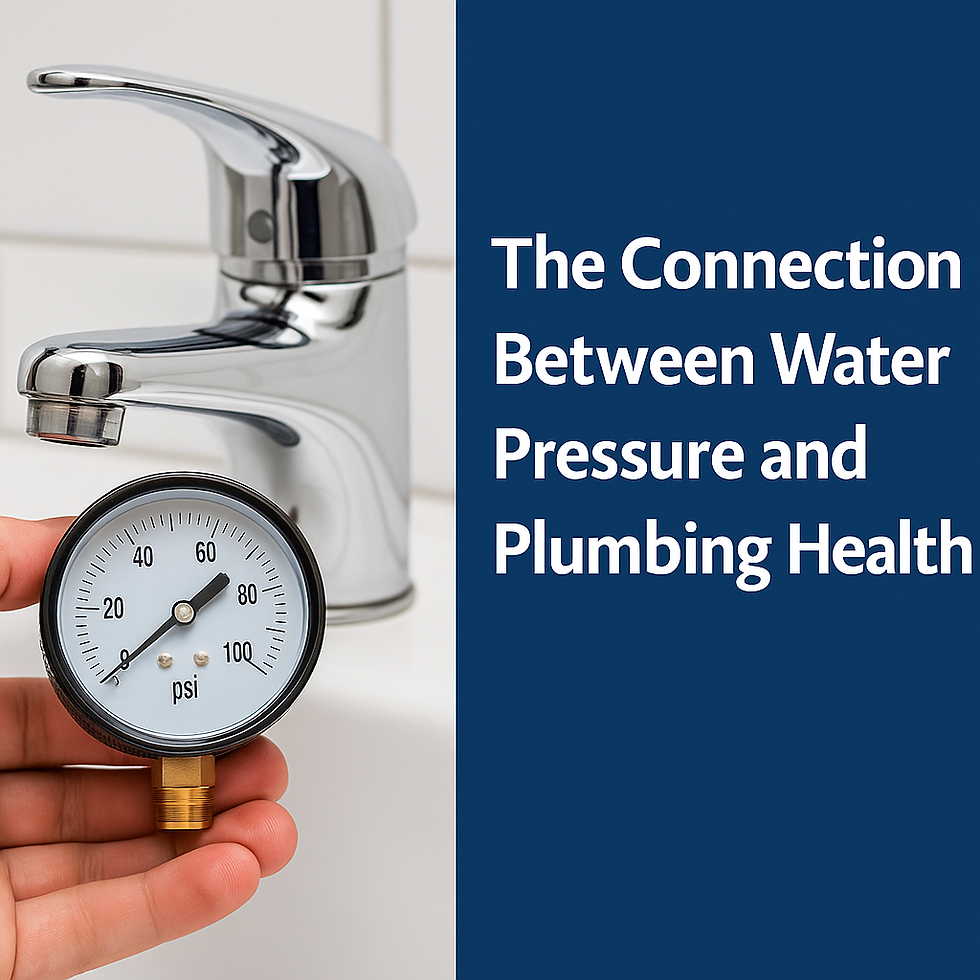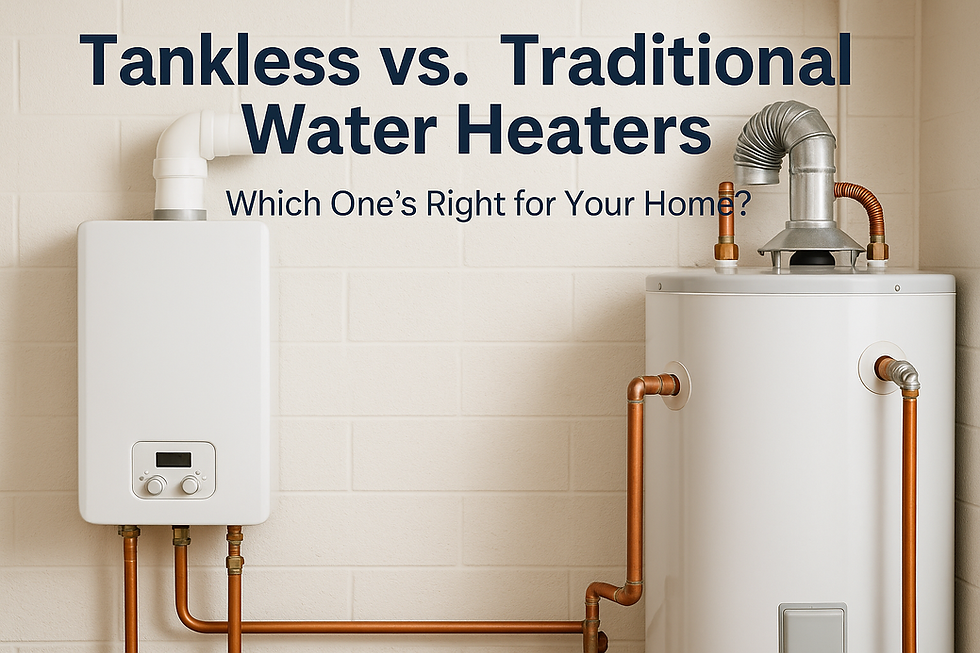The Connection Between Water Pressure and Plumbing Health: What Every Placentia Homeowner Should Know
- Oliver Owens
- Aug 13
- 5 min read
If you’ve ever stood under a trickle of water in the shower wishing for more pressure—or had a blast so strong it felt like your sink faucet might take flight—you already know water pressure matters. But here in Placentia, CA, water pressure isn’t just about comfort; it’s directly tied to the long-term health of your plumbing system.

At Kramer’s Plumbing, we’ve worked on homes where low pressure masked a bigger problem, and others where high pressure was quietly damaging pipes and fixtures behind the scenes. In both cases, homeowners were shocked to learn that what seemed like “just a water pressure quirk” could actually cost them thousands down the road.
Let’s break down what water pressure really does to your plumbing—and how you can keep it in the healthy range.
Why Water Pressure Matters More Than You Think
Water pressure is measured in PSI (pounds per square inch). In most homes, the ideal range is 40–60 PSI. Get too low, and you’ll be waiting forever to fill a pot or rinse shampoo from your hair. Go too high, and you’re putting extra stress on every pipe, joint, and fixture in your house.
Think of your plumbing like the circulatory system in your body. The right “blood pressure” keeps things flowing smoothly. Too little, and you can’t deliver water where it’s needed. Too much, and you risk damaging the “arteries” that keep everything working.
The Risks of Low Water Pressure
1. Everyday Frustration
It’s no secret—low water pressure makes daily tasks a pain. Showers feel weak, washing machines take longer to fill, and dishwashers may not clean effectively. Even something as simple as rinsing vegetables becomes a longer chore.
2. Hidden Pipe Problems
Low pressure can be caused by:
Pipe corrosion
Mineral buildup from Placentia’s moderately hard water
Leaks somewhere in your system
We’ve seen homes where a “minor” drop in pressure was actually a symptom of a slow underground leak—one that had been seeping for months before anyone noticed.
3. Appliance Wear
Appliances designed to run with a certain flow (like tankless water heaters or high-efficiency washers) can struggle under low pressure. This can lead to incomplete cleaning cycles, reduced performance, and more frequent repairs.
The Dangers of High Water Pressure
If low pressure is annoying, high pressure can be downright destructive.
1. Fixture Damage
Your faucets, showerheads, and toilets are built to handle a certain range. Excess pressure can cause washers, gaskets, and seals to fail prematurely, leading to leaks and wasted water.
2. Pipe Stress
Even strong copper or PEX pipes aren’t designed to take constant high-pressure hits. Over time, that stress can cause tiny cracks that eventually burst—often at the worst possible moment.
3. Appliance Failure
High pressure is one of the leading causes of premature water heater failure. It can also damage washing machines, dishwashers, and ice makers. Manufacturers often note in their warranties that damage from high water pressure isn’t covered.
How Placentia’s Water Quality Plays a Role
Placentia’s water has a moderate hardness level, which means minerals like calcium and magnesium are present. Over time, these minerals can:
Build up inside pipes, narrowing the flow
Clog faucet aerators and showerheads
Cause uneven water spray patterns
Accelerate wear on seals and gaskets
If you have a pressure regulator, hard water can shorten its lifespan by causing internal deposits that affect performance. This is one reason why local homeowners may need to replace regulators sooner than the average 10–15 years.
How to Tell If Your Water Pressure Is Too High or Too Low
You don’t have to be a plumber to notice the warning signs.
Low Pressure Indicators:
Weak shower spray
Slow-filling sinks and tubs
Appliances taking longer than normal
Uneven pressure from different faucets
High Pressure Indicators:
Frequent leaks at connections or joints
“Water hammer” (banging noises in pipes)
Toilets running unexpectedly
Appliances wearing out faster than expected
The Simple Tool That Solves Most Problems: The Pressure Regulator
Most modern homes have a pressure-reducing valve (PRV) installed near the main water line. This small but mighty device helps control and stabilize incoming water pressure.
If your PRV is failing or set incorrectly, it can cause constant plumbing stress. Replacing or adjusting it is far less expensive than repairing the damage high pressure can cause.
Professional Testing: The First Step
At Kramer’s Plumbing, we recommend testing your water pressure annually—or immediately if you notice sudden changes. Using a gauge, we can measure pressure levels at different points in your home to spot issues like:
A malfunctioning PRV
A partially closed or blocked main shutoff valve
Shifts in the municipal water supply
Why “Normal” Pressure Might Still Be a Problem
Even if your home’s pressure tests in the “safe” range, swings between low and high pressure can still cause trouble. Inconsistent pressure can be the result of failing valves, outdated piping, or an overloaded municipal supply during peak times.
We’ve seen homes where pressure would drop every evening when the neighborhood was using more water, then spike overnight. That constant fluctuation slowly wore down the home’s plumbing system until leaks started showing up.
Real-Life Example from Placentia
One homeowner called us because their brand-new dishwasher wasn’t cleaning well. We found the water pressure at the appliance’s connection was only 28 PSI due to a partially clogged line. Once we replaced the corroded pipe and cleaned the shutoff valve, the pressure jumped back to normal and the dishwasher worked like a charm.
On the other end of the spectrum, another client had water pressure reading a dangerous 96 PSI. Within a year, they’d replaced a washing machine, repaired a burst supply line under the sink, and patched drywall from a leak. Installing a new PRV and replacing stressed pipes saved them from even bigger repair bills.
Maintenance Tips for Healthy Water Pressure
Test Your Pressure Annually – A $15 gauge or a professional visit can spot problems early.
Flush Your Water Heater – Sediment buildup can reduce hot water flow.
Clean Faucet Aerators & Showerheads – Keeps mineral buildup from affecting flow.
Inspect for Leaks – Even a slow drip can indicate bigger issues.
Replace Old PRVs – Don’t wait until it fails; most last about 10–15 years in ideal conditions, but hard water can shorten that.
Consider a Whole-House Filter or Water Softener – Reduces mineral buildup and prolongs the life of fixtures and appliances.
Where to Learn More
For reliable guidance on water conservation and fixture efficiency, the U.S. Environmental Protection Agency’s WaterSense Program offers resources homeowners can trust.
Kramer’s Plumbing: Your Local Water Pressure Experts
Whether your water pressure feels too weak or dangerously high, our licensed plumbers in Placentia can diagnose the cause and fix it right the first time. From installing new pressure regulators to replacing corroded lines, we’ll make sure your system stays healthy for years to come.
Call Kramer’s Plumbing today to schedule your water pressure check and protect your home’s most important system.
.png)





Comments